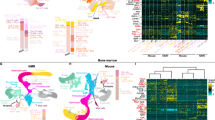Abstract
The Delta-like (DLK1) gene is overexpressed in CD34+ cells from myelodysplastic syndrome (MDS) patients. DLK1 encodes an EGF-like homeotic transmembrane protein homologous to the notch/delta/serrate family. Although exogenous DLK1 promotes maintenance of murine hematopoietic stem cells, the functional effects of DLK1 overexpression in hematopoietic cells are unknown. We show that ectopically expressed DLK1 significantly inhibits differentiation and proliferation of human promyelocytic HL-60 cells. Unlike preadipocytes, where proteolytic processing of membrane-bound protein and release of a soluble form mediates differentiation inhibition, proteolytic release of the extracellular domain was not required for inhibition of hematopoietic cell differentiation. However, intracellular domain interactions were critical to this DLK1 function. We conclude that DLK1 overexpression in hematopoietic cells has important functional consequences. Our studies identify novel molecular mechanisms and indicate that DLK1 has activity both as a soluble and a transmembrane expressed protein. Our results support further investigation of the role of DLK1 in abnormal hematopoiesis in MDS.
This is a preview of subscription content, access via your institution
Access options
Subscribe to this journal
Receive 50 print issues and online access
$259.00 per year
only $5.18 per issue
Buy this article
- Purchase on Springer Link
- Instant access to full article PDF
Prices may be subject to local taxes which are calculated during checkout


Similar content being viewed by others
References
Abdallah BM, Jensen CH, Gutierrez G, Leslie RG, Jensen TG and Kassem M . (2004). J Bone Mineral Res, 19, 841–852.
Allampallam K, Shetty V, Hussaini S, Mazzoran L, Zorat F, Huang R and Raza A . (1999). Anticancer Res, 19, 5323–5328.
Bachmann E, Krogh TN, Hojrup P, Skjodt K and Teisner B . (1996). J Reprod Fertil, 107, 279–285.
Baladron V, Ruiz-Hidalgo MJ, Bonvini E, Gubina E, Notario V and Laborda J . (2002). Biochem Biophys Res Commun, 291, 193–204.
Bauer SR, Ruiz-Hidalgo MJ, Rudikoff EK, Goldstein J and Laborda J . (1998). Mol Cell Biol, 18, 5247–5255.
Bhatia R, Munthe HA, Williams AD, Zhang F, Forman SJ and Slovak ML . (2000). Exp Hematol, 28, 1401–1412.
Costaglioli P, Come C, Knoll-Gellida A, Salles J, Cassagne C and Garbay B . (2001). FEBS Lett, 509, 413–416.
Friedrichsen BN, Carlsson C, Moldrup A, Michelsen B, Jensen CH, Teisner B and Nielsen JH . (2003). J Endocrinol, 176, 257–266.
Garces C, Ruiz-Hidalgo MJ, Bonvini E, Goldstein J and Laborda J . (1999). Differentiation, 64, 103–114.
Greenberg PL, Young NS and Gattermann N . (2002). Hematology (Am Soc Hematol Educ Program), 136–161.
Hofmann WK, de Vos S, Komor M, Hoelzer D, Wachsman W and Koeffler HP . (2002). Blood, 100, 3553–3560.
Jensen CH, Krogh TN, Hojrup P, Clausen PP, Skjodt K, Larsson LI, Enghild JJ and Teisner B . (1994). Eur J Biochem, 225, 83–92.
Kaneta M, Osawa M, Sudo K, Nakauchi H, Farr AG and Takahama Y . (2000). J Immunol, 164, 256–264.
Laborda J, Sausville EA, Hoffman T and Notario V . (1993). J Biol Chem, 268, 3817–3820.
Langer F, Stickel J, Tessema M, Kreipe H and Lehmann U . (2004). Leuk Res, 28, 1081–1083.
Lee YL, Helman L, Hoffman T and Laborda J . (1995). Biochim Biophys Acta, 1261, 223–232.
Mei B, Zhao L, Chen L and Sul HS . (2002). Biochem J, 364, 137–144.
Miyazato A, Ueno S, Ohmine K, Ueda M, Yoshida K, Yamashita Y, Kaneko T, Mori M, Kirito K, Toshima M, Nakamura Y, Saito K, Kano Y, Furusawa S, Ozawa K and Mano H . (2001). Blood, 98, 422–427.
Moore KA, Pytowski B, Witte L, Hicklin D and Lemischka IR . (1997). Proc Natl Acad Sci USA, 94, 4011–4016.
Ramaraj P, Singh H, Niu N, Chu S, Holtz M, Yee JK and Bhatia R . (2004). Cancer Res, 64, 5322–5331.
Raza A, Alvi S, Borok RZ, Span L, Parcharidou A, Alston D, Rifkin S, Robin E, Shah R and Gregory SA . (1997). Leuk Lymphoma, 27, 111–118.
Silver RT, Bennett JM, Deininger M, Feldman E, Rafii S, Silverstein RL, Solberg LA and Spivak JL . (2004). Leuk Res, 28, 979–985.
Smas CM, Chen L and Sul HS . (1997). Mol Cell Biol, 17, 977–988.
Smas CM and Sul HS . (1993). Cell, 73, 725–734.
Sul HS, Smas C, Mei B and Zhou L . (2000). Int J Obes Relat Metab Disord, 24 (Suppl 4), S15–S19.
Van Limpt VA, Chan AJ, Van Sluis PG, Caron HN, Van Noesel CJ and Versteeg R . (2003). Int J Cancer, 105, 61–69.
Walker L, Lynch M, Silverman S, Fraser J, Boulter J, Weinmaster G and Gasson JC . (1999). Stem Cells, 17, 162–171.
Ye Q, Shieh JH, Morrone G and Moore MA . (2004). Leukemia, 18, 777–787.
Acknowledgements
We thank Tinisha McDonald and Helen Xu for their excellent technical assistance. This work was supported in part by the Leukemia Lymphoma Society of America Translational Research Award 6165-02. Ravi Bhatia is a Clinical Scholar of the Leukemia and Lymphoma Society.
Author information
Authors and Affiliations
Rights and permissions
About this article
Cite this article
Li, L., Forman, S. & Bhatia, R. Expression of DLK1 in hematopoietic cells results in inhibition of differentiation and proliferation. Oncogene 24, 4472–4476 (2005). https://doi.org/10.1038/sj.onc.1208637
Received:
Revised:
Accepted:
Published:
Issue Date:
DOI: https://doi.org/10.1038/sj.onc.1208637
Keywords
This article is cited by
-
Germline risk of clonal haematopoiesis
Nature Reviews Genetics (2021)
-
Soluble delta-like 1 homolog (DLK1) stimulates angiogenesis through Notch1/Akt/eNOS signaling in endothelial cells
Angiogenesis (2018)
-
Analysis of the Paternally-Imprinted DLK1–MEG3 and IGF2–H19 Tandem Gene Loci in NT2 Embryonal Carcinoma Cells Identifies DLK1 as a Potential Therapeutic Target
Stem Cell Reviews and Reports (2018)
-
Reduced salivary gland size and increased presence of epithelial progenitor cells in DLK1-deficient mice
Cell and Tissue Research (2016)
-
Delta-like 1 homolog in Capra hircus: molecular characteristics, expression pattern and phylogeny
Molecular Biology Reports (2016)



